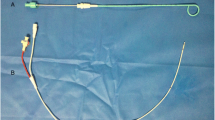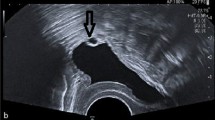Abstract
Introduction and hypothesis
The objective was to assess the outcomes of a one-stage approach to bladder stones in the setting of a vesicovaginal fistula, performing fistula repair concurrently with stone extraction.
Methods
Retrospective review of urogenital fistula surgeries at Evangel VVF Center in Jos, Nigeria, between December 2003 and April 2014, identified 87 women with bladder stones accompanying their fistulas and 2,979 repaired without stones. Concurrent stone extraction and fistula repair were performed in 51 patients. Outcomes were compared with respect to fistula size, classification, and fibrosis.
Results
Women presenting with bladder stones were older and had larger fistulas than those without stones (P < 0.001). Additionally, their fistulas were more often classifiable as large and less often as high (P = 0.02), and were more fibrotic (P = 0.003). Twenty-six (51 %) patients with concurrent repair successfully became dry. Comparing results by classification, concurrent repair of high fistulas with stones was very likely to be successful (OR 8.8, 95% CI 1.0–78.2), whereas low fistulas were not (OR 0.2, 95% CI 0.02–0.7). Outcomes were similar to those of patients without stones, except for low fistulas, which were 5 times more likely to fail (P = 0.04).
Conclusion
Concurrent closure of vesicovaginal fistula at the time of bladder stone extraction is possible and, in many respects, preferable to a staged approach, particularly among high or midvaginal fistulas.
Similar content being viewed by others
References
Creanga AA, Genadry RR. Obstetric fistulas: a clinical review. Int J Gynecol Obstet. 2007;99:S40–6.
Ahmed S, Holtz SA. Social and economic consequences of obstetric fistula; Life changed forever? Int J Gynecol Obstet. 2007;99:S10–5.
Arrowsmith S, Hamlin EC, Wall LL. Obstructed labor injury complex: obstetric fistula formation and the multifaceted morbidity of maternal birth trauma in the developing world. Obstet Gynecol Surv. 1996;51:568–74.
Counseller VS, Haigler FH. Management of urinary-vaginal fistula in 253 cases. Am J Obstet Gynecol. 1955;72:367–76.
Thomas B, Tolley D. Concurrent urinary tract infection and stone disease: pathogenesis, diagnosis and management. Nat Clin Pract Urol. 2008;5:668–74. doi:10.1038/ncpuro1254.
Mahdavi A, Mostafavi H. Hanging bladder calculi secondary to misplaced surgical suture. Iran J Radiol. 2015;12, e11303. doi:10.5812/iranjradiol.11303.
Rajainan S, Kekre NS. Vesicovaginal fistula with large bladder calculus. ANZ J Surg. 2012;82:278–9. doi:10.1111/j.1445-2197.2012.06014.x.
Dalela D, Goel A, Shakhwar SN, Singh KM. Vesical calculi with unrepaired vesicovaginal fistula: a clinical appraisal of an uncommon association. J Urol. 2003;170:2206–8. doi:10.1097/01.ju.0000095503.76155.30.
Ahmed S, Nishtar A, Hafeez GA, Khan Z. Management of vesico-vaginal fistulas in women. Int J Gynecol Obstet. 2005;88:71–5.
Singh K. An unusual complication of vesical stones. Int Urogynecol J. 2002;13:50–1.
Mukerji AC, Ghosh BC, Sharma MM, Taneja OP. Spontaneous urinary fistula caused by vesical calculus. Br J Urol. 1970;42:208–12.
Mahapatra TP, Rao MS, Rao K, Sharma SK, Vaidyanathan S. Vesical calculi associated with vesicovaginal fistulas: management considerations. J Urol. 1986;136:94–5.
Velez A, Ramsey K, Tell K. The campaign to end fistula: what have we learned? Findings of facility and community needs assessments. Int J Gynecol Obstet. 2007;99:S143–50.
Kabir M, Iliyasu Z, Abubakar IS, Umar UI. Medico-social problems of patients with vesico-vaginal fistula in Murtala Mohammed Specialist Hospital. Kano Ann Afr Med. 2004;2:54–7.
Browning A, Fentahun W, Goh J. The impact of surgical treatment on the mental health of women with obstetric fistula. BJOG. 2007;114:1439–41. doi:10.1111/j.1471-0528.2007.01419.x.
Goh JTW, Sloane KM, Krause HG, Browning A, Akhter S. Short communication: mental health screening in women with genital tract fistulae. BJOG. 2005;112:1328–30. doi:10.1111/j.1471-0528.2005.00712.x.
United Nations Population Fund. Report on the meeting for the prevention and treatment of obstetric fistula. London, England. 2001. http://www.unfpa.org/sites/default/files/resource-pdf/fistula_report_2001.pdf Accessed 16 August 2015.
Lawson JB. Tropical gynecology: birth canal injuries. Proc R Soc Med. 1968;61:368–70.
Martius H. Gynecologic operations and their topographic-anatomic fundamentals. Chicago: Debour; 1939.
Meeks GR, Ghafar MA. Vesicovaginal and urethrovaginal fistulas. Glob Libr Women’s Med. 2012. doi:10.3843/GLOWM.10064.
Kirschner CV, Yost KJ, Du H, Karshima JA, Arrowsmith SD, Wall LL. Obstetric fistula: the ECWA Evangel VVF Center surgical experience from Jos, Nigeria. Int Urogynecol J. 2010;21:1525–33.
Goh JTW, Browning A, Berhan B, Chang A. Predicting the risk of failure of closure of obstetric fistula and residual urinary incontinence using a classification system. Int Urogynecol J. 2008;19:1659–62.
Acknowledgements
Funding for fistula surgeries was provided by Fistula Foundation, who had no input into the research or writing.
Author information
Authors and Affiliations
Corresponding author
Ethics declarations
Conflicts of interest
None.
Additional information
Study conducted at: Evangel VVF Center, Bingham University Teaching Hospital, Jos, Plateau State, Nigeria
Rights and permissions
About this article
Cite this article
Shephard, S.N., Lengmang, S.J. & Kirschner, C.V. Bladder stones in vesicovaginal fistula: is concurrent repair an option? Experience with 87 patients. Int Urogynecol J 28, 569–574 (2017). https://doi.org/10.1007/s00192-016-3142-1
Received:
Accepted:
Published:
Issue Date:
DOI: https://doi.org/10.1007/s00192-016-3142-1




